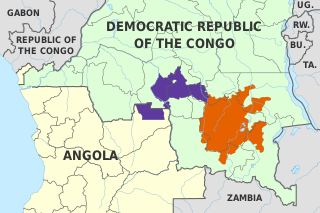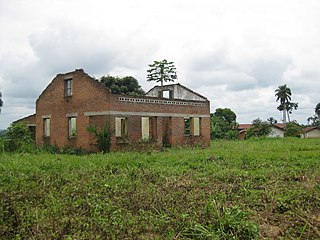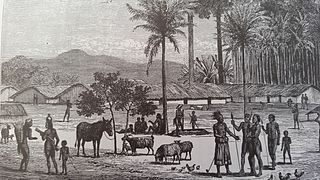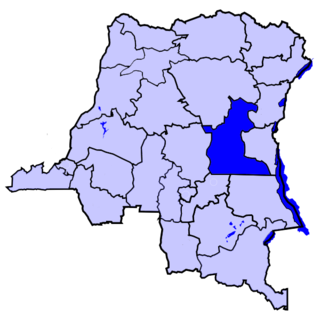
Luba-Kasai, also known as Cilubà or Tshilubà, Luba-Lulua, is a Bantu language of Central Africa and a national language of the Democratic Republic of the Congo, alongside Lingala, Swahili, and Kikongo ya leta.

Kenya, officially the Republic of Kenya, is a country in East Africa. A member of the African Union with a population of more than 47.6 million in the 2019 census, Kenya is the 28th most populous country in the world and 7th most populous in Africa. Kenya's capital and largest city is Nairobi, while its oldest and second largest city, is the major port city of Mombasa, situated on Mombasa Island in the Indian Ocean and the surrounding mainland. Mombasa was the capital of the British East Africa Protectorate, which included most of what is now Kenya and southwestern Somalia, from 1889 to 1907. Other important cities include Kisumu and Nakuru. Kenya is bordered by South Sudan to the northwest, Ethiopia to the north, Somalia to the east, Uganda to the west, Tanzania to the south, and the Indian Ocean to the southeast. Kenya's geography, climate and population vary widely, ranging from cold snow-capped mountaintops with vast surrounding forests, wildlife and fertile agricultural regions to temperate climates in western and rift valley counties and further on to dry less fertile arid and semi-arid areas and absolute deserts.

The Emin Pasha Relief Expedition of 1887 to 1889 was one of the last major European expeditions into the interior of Africa in the nineteenth century. Led by Henry Morton Stanley, its goal was ostensibly the relief of Emin Pasha, the besieged Egyptian governor of Equatoria, who was threatened by Mahdist forces.

Maniema Province is one of 26 provinces of the Democratic Republic of the Congo. Its capital is Kindu. The 2020 population was estimated to be 2,856,300.

Tippu Tip, or Tippu Tib, real name Ḥamad ibn Muḥammad ibn Jumʿah ibn Rajab ibn Muḥammad ibn Saʿīd al Murjabī, was an Afro-Omani ivory and slave owner and trader, explorer, governor and plantation owner. He worked for a succession of the sultans of Zanzibar and was the Sultan of Uterera, a short-lived state in Kasongo, Maniema ruled by himself and his son Sefu who was an Emir with local WaManyema.

Edmund Musgrave Barttelot was a British army officer, who became notorious after his allegedly brutal and deranged behaviour during his disastrous command of the rear column in the Congo during Henry Morton Stanley's Emin Pasha Relief Expedition. He has often been identified as one of the sources for the character of Kurtz in Joseph Conrad's novel Heart of Darkness.
The Zaramo people, also referred to as Dzalamo or Saramo, are a Bantu ethnic group native to the central eastern coast of Tanzania, particularly Dar es Salaam Region and Pwani Region. They are the largest ethnic group in and around Dar es Salaam, the former capital of Tanzania and the 7th largest city in Africa. Estimated to be about 0.7 million people, over 98% of them are Muslims, more specifically the Shafi'i school of Sunni Islam. Zaramo people are considered influential in Tanzania popular culture with musical genres like Sengeli originating from their commonity in Kinondoni District. Their culture and history have been shaped by their dwelling in both urban and rural landscapes.

Manyema (WaManyema) (Una-Ma-Nyema, eaters of flesh) are a Bantu ethnic group, described in the past as powerful and warlike, in the African Great Lakes region of Eastern Africa and Central Africa.

South Africa, officially the Republic of South Africa, is the southernmost country in Africa. It is bounded to the south by 2,798 kilometres (1,739 mi) of coastline that stretches along the South Atlantic and Indian Oceans; to the north by the neighbouring countries of Namibia, Botswana, and Zimbabwe; and to the east and northeast by Mozambique and Eswatini. It also completely enclaves Lesotho. It is the southernmost country on the mainland of the Old World, and the second-most populous country located entirely south of the equator, after Tanzania. South Africa is a biodiversity hotspot, with unique biomes, plant and animal life. With over 62 million people, the country is the world's 23rd-most populous nation and covers an area of 1,221,037 square kilometres. Pretoria is the administrative capital, while Cape Town, as the seat of Parliament, is the legislative capital. Bloemfontein has traditionally been regarded as the judicial capital. The Constitutional Court, the country's highest court, is located in Johannesburg.

Between 1874 and 1877 Henry Morton Stanley traveled Central Africa east to west, exploring Lake Victoria, Lake Tanganyika and the Lualaba and Congo rivers. He covered 7,000 miles (11,000 km) from Zanzibar in the east to Boma at the mouth of the Congo in the west. The expedition resolved several open questions concerning the geography of Central Africa, including identifying the source of the Nile, which he proved was not the Lualaba and is in fact the source of the Congo River.
Daniel P. Biebuyck was a Belgian scholar of Central African art.
The Luban languages are a group of Bantu languages spoken by the Luba people in the south of DRC Congo, established by Christine Ahmed (1995). They constitute half of Guthrie's Zone L. The languages, or clusters, along with their Guthrie identifications, are:
The Maringa-Lopori-Wamba Landscape (MLW) is an ecologically sensitive landscape in the Democratic Republic of the Congo within the Maringa / Lopori basin. Since 1973 a Japanese team has been researching the bonobo population near the village of Wamba, and the Luo Scientific Reserve was established in 1990. However, research was discontinued after political disorder started in 1991 followed by civil war in 1997, resuming only in the mid-2000s.
Bangubangu is a Bantu dialect cluster spoken by the Bangubangu people of the Democratic Republic of the Congo.

The indigenous people within the kasai basin up to Maniema understood themselves to be descendants of "AnKutshu Membele", then in the 20th century many accepted the imposed term Tetela . "Batetela" is now understood as an ethnic group of the Democratic Republic of the Congo, most of whom speak the Tetela language.

Achille Emile Meeussen, also spelled Achiel Emiel Meeussen, or simply A.E. Meeussen (1912–1978) was a distinguished Belgian specialist in Bantu languages, particularly those of the Belgian Congo, Rwanda and Burundi. Together with the British scholar Malcolm Guthrie (1903–1972) he is regarded as one of the two leading experts in Bantu languages in the second half of the 20th century.
The Goma, who also refer to themselves as Al ghamawiyyun in Arabic, are a tribe in the Kigoma Region in western Tanzania. They are a contingent of the Bantu tribe who are more commonly found in Tanzania and present-day Democratic Republic of Congo who migrated from the western shore of the Lake Tanganyika in Democratic Republic of Congo with origins from Sudan. They are the first group of the Bantu tribe to ever cross the Lake Tanganyika and also the first group to reside in the Urban District of Kigoma as its inhabitants. Following the Wagoma were Niakaramba (Kwalumona) from Cape Karamba and then Wabwari from Ubwari peninsula. The Kwalumona merged within Wabwari, identified themselves as Bwaris and settled north of Wagoma in Kigoma before resettling in Ujiji and its environs, where they formed a tribal Confederacy in Ujiji known as Wamanyema. The Wagoma crossed the lake early due to their invention of dug-out canoes mitumbwi ya mti mmoja curved from Mivule trees of Ugoma mountains from western shore of the Lake.

Maniema District was a district of the Belgian Congo and the Democratic Republic of the Congo. It roughly corresponded in area to the present Maniema province.
Mwene Mbonwean Sultanate of Ujiji or Busonga is a subnational Monarchy in Ujiji town, Kigoma Region, western Tanzania. The seat of the local Sultanate is Busaid which was called so from the name of the dynasty of both the Zanzibar Sultanate and Oman which once ruled Ujiji under Arab-Swahili Liwalis, the post Arab name of Busaid for Ujiji proper is still used by the locals as "Busaidi".











